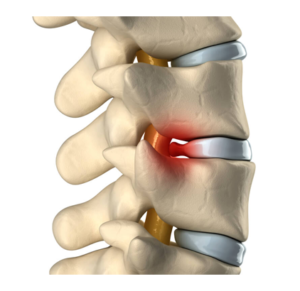What is a Ruptured Disc?
A ruptured disc, also called a herniated disc, is a common condition that occurs when one of the spinal discs develops a crack in its tough outer wall and its inner disc material is pushed out into the spinal canal. This can result in pain and other symptoms if any displaced disc material puts pressure on the spinal cord or an exiting nerve root.
If discomfort and limited mobility from a ruptured disc have become debilitating and make it difficult for you to accomplish even simple tasks, learning about your condition through the following article is important. Being able to ask the right questions to your primary care doctor and better understand the answers may help you better get the care you need to resume a healthy and active life.

Causes of a Ruptured Disc
Ruptured discs can develop anywhere in the spine. Most develop in the lumbar (lower) spine, although the cervical (upper) spine area is also a common location for a ruptured disc. In many cases, a ruptured disc develops as a result of regular, age-related wear. The discs are made of soft but strong connective tissue and act as shock absorbers for the pressure placed on the neck and back every day. Throughout a person’s lifetime, these discs gradually lose the elasticity and water content that help keep them flexible.
The deterioration of the discs can cause the formation of small cracks to develop in the outer wall, which can further develop into full tears. Pressure from the surrounding vertebrae can then cause the fluid in the core of the disc to be pushed out through the tear and into the spinal column. Less commonly, a rupture can also be caused by a sudden traumatic injury such as a car crash. People whose jobs involve prolonged exposure to the regular lifting of heavy items are also prone to disc ruptures.
Ruptured Disc Symptoms
It is possible to have a ruptured disc and experience few to no symptoms. However, if there is any nerve compression or irritation resulting from the disc rupturing, the following symptoms can result:
- Local pain
- Shooting or burning pain that travels the length of the nerve
- Numbness
- Muscle weakness
- Tingling
- Loss of movement
Risk Factors of a Ruptured Disc
Accidents, sudden injuries or genetic disorders are risk factors for a ruptured disc that cannot be foreseen or prevented. However, if a disc herniates or bulges due to gradual deterioration, there are a variety of things you can do to stop or slow the process.
For example, since damaged discs often have to do with a weakened disc wall, restoring some elasticity to the outer disc layer is crucial. In order for your disc to heal, you must promote overall spine health with the following daily choices:
- Drink plenty of water
- Stretch frequently
- Stop smoking
- Eat foods high in healthy oils and omega fatty acids, like salmon, avocado and nuts
- Lose weight to relieve unnecessary pressure on your spine
- Exercise to lose weight and strengthen your core muscles which support your spine
Make sure to talk to your physician before you start any exercise or diet routine to prevent strain or injury.
Stages that Lead to a Ruptured Disc
Research has shown that deterioration of the spinal anatomy actually begins in the second decade of life. By the time we reach middle age, many of us have already experienced one or more of the stages of disc degeneration that can lead to a ruptured disc. These stages typically include:
- Degeneration. Discs begin to dry out and lose protein content, diminishing their ability to provide a cushion between vertebrae; the outer wall becomes brittle and the disc begins to lose height.
- Prolapse. Eventually, a portion of the gel-like substance at the center of the disc can press outward and causes a protrusion through the outer layer.
- Extrusion. A tear develops in the outer layer, causing disc matter to be pushed out into the spinal canal. This is the stage that would be diagnosed as a ruptured disc.
- Sequestration. The herniated disc material has broken free from the disc and is loose within the spinal canal.
Ruptured Disc Treatment
If you are experiencing any of these symptoms, be sure to contact your doctor. He or she will be able to determine the cause of the pain and the best possible treatments. When diagnosing a ruptured disc, your health care provider likely will perform a physical exam and may order an X-ray, CT scan or MRI for confirmation. Conservative treatment options could include over-the-counter medication, prescription medication, physical therapy, and lifestyle changes.